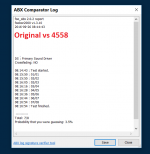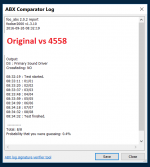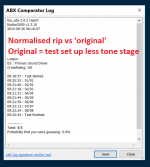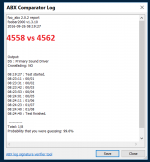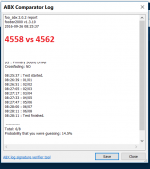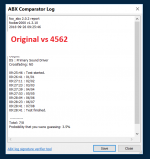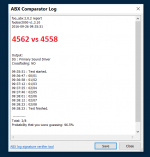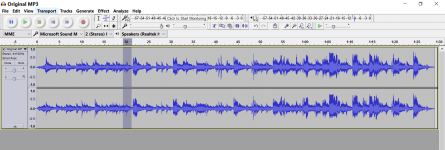I'm sure this must have been discussed but just what does Foobar convert files too when you ABX them ?
.
Pretty obvious that you can't send any compressed format to a DAC, any compressed format has to be decompressed to serial L/R data which is the same as WAV. No idea about the 2x size except that it might be set up to express all raw data as 32 bit numbers to accommodate 24bit samples.
Last edited:
...files...
esmeralda sounds best(little bit) , others sound same to me.
used ,foobar v1.3.12 with wasapi ,pcm2706 dac feeding akg k240 mk2
btw what is that background noise??
11 years of working with them. Go be happy with your grit machineYou'll have some actual evidence then rather than anecdotes and conjecture.
11 years of working with them. Go be happy with your grit machine
That would be no then...
Okay, maybe someone can link me to the correct book.
It's been highly recommended by many of y'all.
It has been said that the company has you by the balls
because they have a captive audience so new copy's
of the book are expensive.
I saw a link once perhaps within the last week or two,
sorry I can't remember when. And the book didn't have
the standard author...I didn't recognize the name. He could
have been the editor.
Maybe it wasn't op amps maybe it was transistors, but I think
it was op amps.
I've spent days trying to find it again but I can't.
So if any off y'all can figure out which book I sure
would appreciate it.
I can't even find the thread again when someone
linked to it on amazon. And no I couldn't figure out
which book it was there either, so I can't say what
the title even was. For some reason I thought
it was from a head phone amp thread but I don't know.
Any help appreciated.
Cheers,
Sync
It's been highly recommended by many of y'all.
It has been said that the company has you by the balls
because they have a captive audience so new copy's
of the book are expensive.
I saw a link once perhaps within the last week or two,
sorry I can't remember when. And the book didn't have
the standard author...I didn't recognize the name. He could
have been the editor.
Maybe it wasn't op amps maybe it was transistors, but I think
it was op amps.
I've spent days trying to find it again but I can't.
So if any off y'all can figure out which book I sure
would appreciate it.
I can't even find the thread again when someone
linked to it on amazon. And no I couldn't figure out
which book it was there either, so I can't say what
the title even was. For some reason I thought
it was from a head phone amp thread but I don't know.
Any help appreciated.
Cheers,
Sync
Thanks for trying, but nope, that wasn't it. I've got that : )The Art of Electronics, 3rd Edition? If so, It's well worth the cost.
It is a manufactures book, but not by Jim, Bob, or Walt.
It was a name I didn't recognize. Like maybe Jeti or something like that?
Not a book, but there are many interesting links in post #64.
Looking back, I found that thread has been around longer than I thought.
Looking back, I found that thread has been around longer than I thought.
After a bit of listening to those comparison files, I picked out one cymbal hit somewhere near the end and just used that. I do hear variation in attack punchiness, noise, and some other things. One almost sounds like drum synth sounds. Another almost like a very small egg shaped percussion shaker. For esmerelda, there is some faint modulation to the cymbal sound as though there is a short delay and reverb added to the sound. Overall there is so much hiss, noise, and distortion on everything, none of it sounds close to real. After listening a while I am already getting fatigued and need to take a break for my hearing to come back. Sheesh.
Thanks Mark. Even if you don't want to commit to saying one is better than another, could you share which perhaps sounded 'different'.
Pretty obvious that you can't send any compressed format to a DAC, any compressed format has to be decompressed to serial L/R data which is the same as WAV. No idea about the 2x size except that it might be set up to express all raw data as 32 bit numbers to accommodate 24bit samples.
I sort of rather hazily guessed that both files would need to be put into the same format to allow comparison but I'm a bit clueless on the detail.
Thanks.
esmeralda sounds best(little bit) , others sound same to me.
used ,foobar v1.3.12 with wasapi ,pcm2706 dac feeding akg k240 mk2
btw what is that background noise??
Audible background noise you mean ?
Although the listener sample is only small at the moment, the comments are really interesting. Don't be afraid to post what you hear.
Thanks for listening toni... any one else going to give these a listen.
It is a manufactures book, but not by Jim, Bob, or Walt.
Could it be this one? Ticks the manufacturer box and has 'Op Amps' in the title.
https://www.amazon.com/Intuitive-Amps-Basics-Useful-Applications/dp/9997796675/ref=sr_1_fkmr1_1?s=books&ie=UTF8&qid=1474876226&sr=1-1-fkmr1&keywords=intuitive+IC+opamps
I listened the files and I did get couple "aha" moments but they were because I was unfamiliar with the music and I just noticed new things as I played the files more. I kept track of each of those moments and later compared those parts between different files and couldn't hear anything I consider significant. If the test recording was some track I was very familiar with I could perhaps notice something more, having said that I didn't put too much effort into memorizing every aspect of the track so I never hard any real solid comparison points when listening apart from the few "aha" moments I mentioned.
Where I did hear difference was the noise in the recordings, all of them sounded slightly different. I would say it doesn't count because if you recorded same hardware twice or more times all of these recordings will have the noise sounding different, due to the kinda random nature of noise lol.
Where I did hear difference was the noise in the recordings, all of them sounded slightly different. I would say it doesn't count because if you recorded same hardware twice or more times all of these recordings will have the noise sounding different, due to the kinda random nature of noise lol.
yes audible noise, i never heard original recording so maybe its something that is normal because it is apparent in all tracks. very nice vocals.
Where I did hear difference was the noise in the recordings, all of them sounded slightly different. I would say it doesn't count because if you recorded same hardware twice or more times all of these recordings will have the noise sounding different, due to the kinda random nature of noise lol.
Agreed, the noise does sound different in each one. In some it is more distorted, grainy, bright/sparkly. In one it is particularly softer, smoother, more dull, sounds like less HF altogether, but doesn't sound better. There may be 2 where I could hear a little modulation on the cymbal, I said before like a delay with reverb, but I would say like a very short repeating delay and reverb. Sometimes delays are used like that to create a very sparse early reflection effect. What is hard is trying to identify whats there, think of words to describe, try to remember all the details from one to another when there is no exact words (no established technical language) to describe the differences. I would encourage anyone to pick a quiet spot in the recordings and loop that spot. Listen to the noise, which is different. Then listen to the vocals and you can hear some of it on them, but they contain less HF than the noise or cymbals, so there is less of the differences on the vocals.
Thanks Tiido 🙂
I've just been giving these a more critical listen via headphones playing at modest volume (Sony MDR-V7) and with the electronics set to a flat response.
First thing to say is a big thanks to all that do listen and compare because as I'm finding out again, its hard work and very tiring.
For my own satisfaction I've compared the 4562 and 4558 against the 'original' and also against a normalised (volume equalised) rip of the test track. Original here means the track being played on the Philips spinner and recorded directly to the PC. No tone stage in circuit.
I'm pleased to say that I can differentiate the two opamps from the two 'originals' fairly easily.
Where I can't statistically show any preference is for the 4558 vs the 4562. I'm disappointed in that but its a fact.
Does that indicate anything ? Are the opamps all more than capable of doing the job asked of them in this application or is some other limitations of the test/PC set up masking things.
I'm struggling with the fact I can't differentiate what should be the best of the best from the worst of the worst opamp wise.
What is also obvious is that for a casual listener, five files is way to much. It really does have to be one vs another and not much more than that.
Non the less, your comments have been very interesting...... more on that later 😉
I can post the original file and the normalised rip if anyone is interested.
I've just been giving these a more critical listen via headphones playing at modest volume (Sony MDR-V7) and with the electronics set to a flat response.
First thing to say is a big thanks to all that do listen and compare because as I'm finding out again, its hard work and very tiring.
For my own satisfaction I've compared the 4562 and 4558 against the 'original' and also against a normalised (volume equalised) rip of the test track. Original here means the track being played on the Philips spinner and recorded directly to the PC. No tone stage in circuit.
I'm pleased to say that I can differentiate the two opamps from the two 'originals' fairly easily.
Where I can't statistically show any preference is for the 4558 vs the 4562. I'm disappointed in that but its a fact.
Does that indicate anything ? Are the opamps all more than capable of doing the job asked of them in this application or is some other limitations of the test/PC set up masking things.
I'm struggling with the fact I can't differentiate what should be the best of the best from the worst of the worst opamp wise.
What is also obvious is that for a casual listener, five files is way to much. It really does have to be one vs another and not much more than that.
Non the less, your comments have been very interesting...... more on that later 😉
I can post the original file and the normalised rip if anyone is interested.
Attachments
I was thinking of using one of the cymbal hits as a reference, then making a new track where the reference cymbal hit plays first, then one of the other hits. Alternate, 1,2,1,3,1,4, etc. so that each one has in immediate prior reference to compare it to. Might help for thinking of how to describe how they sound in relative terms since there seems to be multiple variables of sound (different distortion mechanisms and/or in different ratios, for each track) involved in the differences.
In one it is particularly softer, smoother, more dull, sounds like less HF altogether, but doesn't sound better. There may be 2 where I could hear a little modulation on the cymbal,.......
In the screen shots above I used just this highlighted segment to do the comparisons.
but doesn't sound better
This says it all. Each file taken in isolation is perfectly acceptable to me. Here we are straining to hear minutia differences.
The differences here are very very small imo.
Attachments
This says it all. Each file taken in isolation is perfectly acceptable to me.
Not to me. Two problems here: (1) when mixing and recording, distortion sources like this accumulate with every process a signal goes through. It gets more and more ugly, until is sounds like really bad digital. I can't listen to that. I bought one CD of a band I like and had to throw it away because I could only listen to a few seconds of each track before being grossed out at the brittle, harsh, ugly sound of it.
(2) The debates here keeps switching between 2 standards without anybody taking note of what is going on. People have been ridiculed and called crazy for claiming to hear something that can't possibly be there. Now, when we see there is something there, we forget about all the bad, rude, insulting behavior, and dismiss those things by saying, "Oh, well, it doesn't matter for most purposes, so I was right all along anyway." You know who you are.
- Status
- Not open for further replies.
- Home
- General Interest
- Everything Else
- What is wrong with op-amps?
